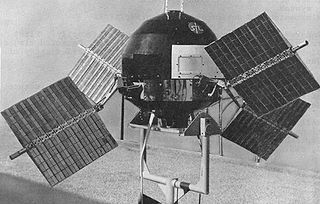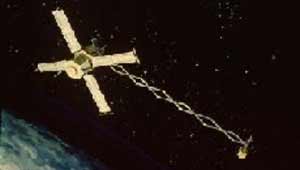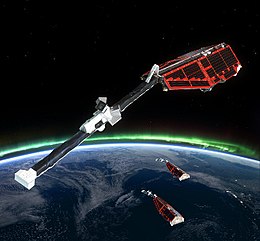
Space weather is a branch of space physics and aeronomy, or heliophysics, concerned with the varying conditions within the Solar System and its heliosphere. This includes the effects of the solar wind, especially on the Earth's magnetosphere, ionosphere, thermosphere, and exosphere. Though physically distinct, space weather is analogous to the terrestrial weather of Earth's atmosphere. The term "space weather" was first used in the 1950s and popularized in the 1990s. Later, it prompted research into "space climate", the large-scale and long-term patterns of space weather.

The Swedish Institute of Space Physics is a Swedish government agency. The institute's primary task is to carry out basic research, education and associated observatory activities in space physics, space technology and atmospheric physics.

Cascade, Smallsat and Ionospheric Polar Explorer (CASSIOPE), is a Canadian Space Agency (CSA) multi-mission satellite operated by the University of Calgary. The mission development and operations from launch to February 2018 was funded through CSA and the Technology Partnerships Canada program. In February, 2018 CASSIOPE became part of the European Space Agency's Swarm constellation through the Third Party Mission Program, known as Swarm Echo, or Swarm-E. It was launched September 29, 2013, on the first flight of the SpaceX Falcon 9 v1.1 launch vehicle. CASSIOPE is the first Canadian hybrid satellite to carry a dual mission in the fields of telecommunications and scientific research. The main objectives are to gather information to better understand the science of space weather, while verifying high-speed communications concepts through the use of advanced space technologies.

Explorer 6, or S-2, was a NASA satellite, launched on 7 August 1959, at 14:24:20 GMT. It was a small, spheroidal satellite designed to study trapped radiation of various energies, galactic cosmic rays, geomagnetism, radio propagation in the upper atmosphere, and the flux of micrometeorites. It also tested a scanning device designed for photographing the Earth's cloud cover. On 14 August 1959, Explorer 6 took the first photos of Earth from a satellite.

Rokot, also transliterated Rockot, was a Soviet Union space launch vehicle that was capable of launching a payload of 1,950 kilograms (4,300 lb) into a 200-kilometre (120 mi) Earth orbit with 63° inclination. It was based on the UR-100N intercontinental ballistic missile (ICBM), supplied and operated by Khrunichev State Research and Production Space Center. The first launches started in the 1990s from Baikonur Cosmodrome out of a silo. Later commercial launches commenced from Plesetsk Cosmodrome using a launch ramp specially rebuilt from one for the Kosmos-3M launch vehicle. The cost of the launcher itself was about US$15 million in 1999; The contract with European Space Agency (ESA) for launching Swarm in September 2013 was worth €27.1 million.

The Gravity Field and Steady-State Ocean Circulation Explorer (GOCE) was the first of ESA's Living Planet Programme heavy satellites intended to map in unprecedented detail the Earth's gravity field. The spacecraft's primary instrumentation was a highly sensitive gravity gradiometer consisting of three pairs of accelerometers which measured gravitational gradients along three orthogonal axes.

Challenging Minisatellite Payload (CHAMP) was a German satellite launched July 15, 2000 from Plesetsk, Russia and was used for atmospheric and ionospheric research, as well as other geoscientific applications, such as GPS radio occultation, gravity field determination, and studying the Earth's magnetic field.

Constellation Observing System for Meteorology, Ionosphere, and Climate (COSMIC) is a program designed to provide advances in meteorology, ionospheric research, climatology, and space weather by using GPS satellites in conjunction with low Earth orbiting (LEO) satellites. The term "COSMIC" may refer to either the organization itself or the constellation of 6 satellites. The constellation is a joint U.S.-Taiwanese project with major participants including the University Corporation for Atmospheric Research (UCAR), the National Science Foundation, the Naval Research Laboratory (NRL), the Air Force Research Laboratory (AFRL), SRI International on the U.S. side and the National Space Organization (NSPO) on the Taiwanese side.

Ørsted is an Earth science satellite launched in 1999 to study the Earth's geomagnetic field. It is Denmark's first satellite, named after Hans Christian Ørsted (1777–1851), a Danish physicist and professor at the University of Copenhagen, who discovered electromagnetism in 1820.
Dynamics Explorer was a NASA mission, launched on 3 August 1981, and terminated on 28 February 1991. It consisted of two unmanned satellites, DE-1 and DE-2, whose purpose was to investigate the interactions between plasmas in the magnetosphere and those in the ionosphere. The two satellites were launched together into polar coplanar orbits, which allowed them to simultaneously observe the upper and lower parts of the atmosphere.

In geophysics, a magnetic anomaly is a local variation in the Earth's magnetic field resulting from variations in the chemistry or magnetism of the rocks. Mapping of variation over an area is valuable in detecting structures obscured by overlying material. The magnetic variation in successive bands of ocean floor parallel with mid-ocean ridges was important evidence for seafloor spreading, a concept central to the theory of plate tectonics.

The Magnetospheric Multiscale (MMS) Mission is a NASA robotic space mission to study the Earth's magnetosphere, using four identical spacecraft flying in a tetrahedral formation. The spacecraft were launched on 13 March 2015 at 02:44 UTC. The mission is designed to gather information about the microphysics of magnetic reconnection, energetic particle acceleration, and turbulence — processes that occur in many astrophysical plasmas. As of March 2020, the MMS spacecraft have enough fuel to remain operational until 2040.
The Living Planet Programme (LPP) is a programme within the European Space Agency which is managed by the Earth Observation Programmes Directorate. LPP consists of two classes of Earth observation missions including research missions known as Earth Explorers, and the Earth Watch class of missions whose objective is to develop support operational applications such as numerical weather forecasting or resource management.

Magsat was a NASA/USGS spacecraft, launched on 30 October 1979. The mission was to map the Earth's magnetic field, the satellite had two magnetometers. The scalar and vector magnetometers gave Magsat a capability beyond that of any previous spacecraft. Extended by a telescoping boom, the magnetometers were distanced from the magnetic field created by the satellite and its electronics. The satellite carried two magnetometers, a three-axis fluxgate magnetometer for determining the strength and direction of magnetic fields, and an ion-vapor/vector magnetometer for determining the magnetic field caused by the vector magnetometer itself. Magsat is considered to be one of the more important Science/Earth orbiting satellites launched; the data it accumulated is still being used, particularly in linking new satellite data to past observations.

Spacecraft magnetometers are magnetometers used aboard spacecraft and satellites, mostly for scientific investigations, plus attitude sensing. Magnetometers are among the most widely used scientific instruments in exploratory and observation satellites. These instruments were instrumental in mapping the Van Allen radiation belts around Earth after its discovery by Explorer 1, and have detailed the magnetic fields of the Earth, Moon, Sun, Mars, Venus and other planets and moons. There are ongoing missions using magnetometers, including attempts to define the shape and activity of Saturn's core.

CryoSat-1, also known as just CryoSat, was a European Space Agency satellite which was lost in a launch failure in 2005. The satellite was launched as part of the European Space Agency's CryoSat mission, which aims to monitor ice in the high latitudes. The second mission satellite, CryoSat-2, was successfully launched in April 2010.

Sentinel-5 Precursor (Sentinel-5P) is an Earth observation satellite developed by ESA as part of the Copernicus Programme to close the gap in continuity of observations between Envisat and Sentinel-5.

Solar wind Magnetosphere Ionosphere Link Explorer (SMILE) is a planned joint venture mission between the European Space Agency and the Chinese Academy of Sciences. SMILE will image for the first time the magnetosphere of the Sun in soft X-rays and UV during up to 40 hours per orbit, improving our understanding of the dynamic interaction between the solar wind and Earth's magnetosphere. The prime science questions of the SMILE mission are
CSES , or Zhangheng, is a Chinese–Italian space mission dedicated to monitoring electromagnetic field and waves, plasma parameters and particle fluxes induced by natural sources and artificial emitters in the near-Earth space. Austria contributes to one of the magnetometers.

Dynamics Explorer 2 was a NASA low-altitude mission, launched on 3 August 1981. It consisted of two satellites, DE-1 and DE-2, whose purpose was to investigate the interactions between plasmas in the magnetosphere and those in the ionosphere. The two satellites were launched together into polar coplanar orbits, which allowed them to simultaneously observe the upper and lower parts of the atmosphere.


















